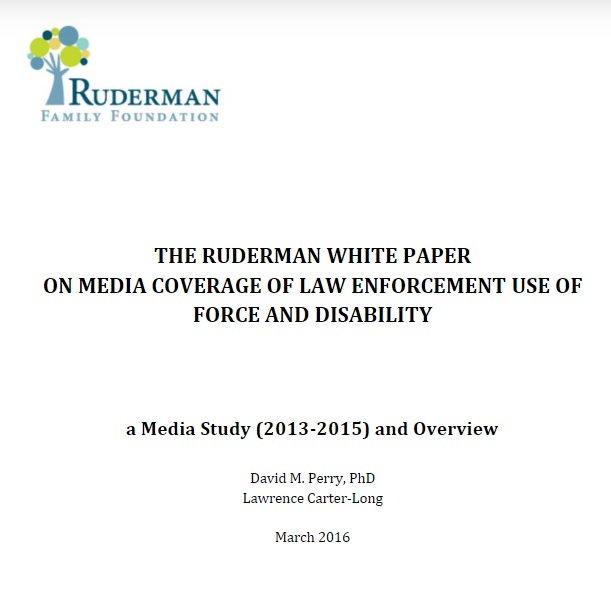DF version available for download here
Disability is the missing word in media coverage of police violence.
For a searchable database of all 2013-2015 news coverage of police violence involving persons with disabilities, click here.
EXECUTIVE SUMMARY
Disability is the missing word in media coverage of police violence.
Disabled individuals make up a third to half of all people killed by law enforcement officers. Disabled individuals make up the majority of those killed in use-of-force cases that attract widespread attention. This is true both for cases deemed illegal or against policy and for those in which officers are ultimately fully exonerated. The media is ignoring the disability component of these stories, or, worse, is telling them in ways that intensify stigma and ableism.
When we leave disability out of the conversation or only consider it as an individual medical problem, we miss the ways in which disability intersects with other factors that often lead to police violence. Conversely, when we include disability at the intersection of parallel social issues, we come to understand the issues better, and new solutions emerge.
Contents
Disability intersects with other factors such as race, class, gender, and sexuality, to magnify degrees of marginalization and increase the risk of violence. When the media ignores or mishandles a major factor, as we contend they generally do with disability, it becomes harder to effect change.
This white paper focuses on the three years of media coverage of police violence and disability since the death of a young man with Down syndrome, named Ethan Saylor, in January 2013. After reviewing media coverage of eight selected cases of police violence against individuals with disabilities, the paper reveals the following patterns in the overall data:
- Disability goes unmentioned or is listed as an attribute without context.
- An impairment is used to evoke pity or sympathy for the victim.
- A medical condition or “mental illness” is used to blame victims for their deaths.
- In rare instances, we have identified thoughtful examinations of disability from within its social context that reveal the intersecting forces that lead to dangerous use-of-force incidents. Such stories point the way to better models for policing in the future.
We conclude by proposing best practices for reporting on disability and police violence.
Content Analysis
How often do American police use force against disabled civilians? No one knows because we lack comprehensive data sets. Currently, there is no legal requirement for local, state or federal law enforcement agencies to aggregate or collect the number, type, and result of violent incidents that occur between police officers and disabled people. From a purely practical standpoint, those who seek to track, monitor, and/or analyze trends related to police violence and disability are limited to collecting the data themselves from print and online media coverage.
From individual cases to a broad analysis of media representation of incidents of police violence against disabled people, we have compiled and summarized media coverage of stories about police violence and disability by year, organized the stories into various categories, and offered brief commentary on a few examples.
Our review and analysis reflects the patterns of media coverage on issues related to disability and police violence. Generally speaking, reporting on police violence against disabled people includes the date of the incident along with specific details about when and where the event occurred. Using this as our starting point, we added the reactions of law enforcement agencies and community responses to allegations of police violence as reported wherever possible.
We close by offering some ideas for “best practices” that journalists might consider when reporting cases linking police violence and disability.
As an addendum to this white paper, we have prepared an online spreadsheet which can be searched by name, date, state, and disability.
Conclusion
Twenty-five years after the U. S. Congress passed the Americans with Disabilities Act, notions of disability continue to evolve. An increasingly powerful set of concepts, they push us to redefine how to build an inclusive society that is accessible to all.
When disabled Americans get killed and their stories are lost or segregated from each other in the media, we miss an opportunity to learn from tragedies, identify patterns, and push for necessary reforms.
Disability rights are civil rights. Disability rights are human rights and disability justice is intersectional.
The needs of disabled people aren’t special. There is nothing special about not wanting to be shot. What disabled people seek are the same things (employment, education, access, consideration, respect, etc.) that non-disabled people likewise desire. The obstacles faced by disabled people, though, too often go unseen. The language used to report issues that confront disabled people—especially issues linked to injury and death—should reflect that disparate reality.

